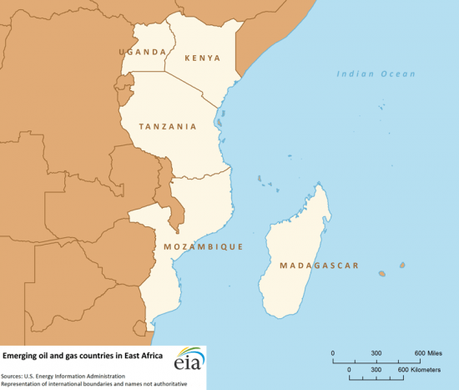
Emerging oil and gas countries in East Africa (Source: U.S. Energy Information Administration)
Until the last few years East Africa was a sleepy backwater for the oil and gas industry, but the discovery of significant quantities of oil in Uganda followed by hydrocarbon discoveries in Kenya, Tanzania and Mozambique have started a gold rush. Now every potential hydrocarbon basin across East Africa is the subject of intense interest.
This new regional analysis covers emerging developments in the oil and gas sectors in five East African countries: Mozambique, Tanzania, Uganda, Kenya, and Madagascar. The larger area that EIA considers as East Africa (see Africa by region map) includes 21 countries. In this region, by far the largest oil and gas producers are Sudan and South Sudan, which are not covered in this report because they are mature oil producers.
Among the countries with emerging oil and gas developments, Mozambique, Tanzania, Uganda, and Madagascar have shown the most progress toward commercial development of newly discovered resources in recent years. Uganda and Madagascar will most likely be the next new oil producers on the continent. Mozambique will probably be the first country in East Africa to develop the capability to export liquefied natural gas (LNG), possibly followed by Tanzania.
Although progress toward commercial development of hydrocarbon resources in Kenya has been modest, the country plays a vital role in the region as an oil transit hub, particularly for oil products coming into the region. Kenya is planning to expand its role by embarking on a multi-million dollar investment to increase its midstream and downstream capacity.
Mozambique 32-65 Tcf of recoverable gas resources in Area 1 (Anadarko) and 75 Tcf gas in place in Area 4 (Eni) LNG Plant and supporting infrastructure Anadarko and Eni
Tanzania More than 20 Tcf of recoverable gas resources in Blocks 1-4 LNG Plant and supporting infrastructure BG Group, Statoil, Ophir Energy, ExxonMobil, Aminex
Uganda 18 commercially viable oil and gas fields from 2006 to 2011 oil refinery in Uganda and export pipeline via Kenya Tullow, Total, CNOOC
Kenya Ngamia-1 and Twiga South-1 oil wells in 2012 new reversible product pipeline to Uganda; replace Mombasa to Nairobi product pipeline; increase capacity at Mombasa Port; LAPSSET project Tullow
Madagascar Heavy oil at the Tsimiroro field oil pipeline from Tsimiroro to the coast; oil export terminal; supporting infrastructure Madagascar Oil
The information above is current as of April 2013.The “Companies” category only includes those that made notable oil and gas discoveries or are currently leading activities. CNOOC is China National Offshore Oil Corporation.Source: Tullow, Total, Madagascar Oil, Anadarko, Eni, BG Group, Statoil, Aminex, Kenya Ports Authority, Kenya Pipeline Company, Rystad Energy,Global Insight, PFC Energy, Oil & Gas Journal, and Energy
Currently, oil and gas production and proved reserves are limited in East Africa. In comparison to other regions on the continent, East Africa produced the least amount of oil in 2012, was the second smallest gas producer in 2011, held the second lowest level of proved oil and gas reserves as of January 1, 2013, and had the second lowest crude oil refinery capacity in 2012, given the latest available estimates.
Almost all of East Africa’s oil production derives from Sudan and South Sudan, which was substantially curtailed in 2012 because South Sudan shut in all of its production for almost the entire year. Although Sudan and South Sudan are important energy producers in the region, they are not covered in this report because they are mature oil producers, rather than emerging exploration and development areas.
In 2012, total oil production in East Africa, other than Sudan and South Sudan, was less than 1,000 barrels per day (bbl/d), all of which was biofuels production from various countries. Also, with the exception of Sudan and South Sudan, there are no crude oil producers in the region, and only two countries held proved oil reserves as of January 1, 2013: Uganda (2.5 billion barrels) and Ethiopia (430 million barrels). East Africa holds 8 percent of the continent’s total crude oil refinery capacity, which is located in Sudan, Kenya, Zambia, Tanzania, and Eritrea. Mozambique and Tanzania are the only natural gas producers, with an output of 135 billion cubic feet (Bcf) and 30 Bcf of dry natural gas in 2011, respectively. Proved natural gas reserves are held in Mozambique, Sudan and South Sudan, Tanzania, Rwanda, Ethiopia, Uganda, and Somalia.
East Africa3 122 7.5 165 11.3 265
Southern Africa4 181 0.0 45 2.8 485
West Africa 2667 38.0 1161 184.8 604
Central Africa 2912 17.1 318 23.2 121
North Africa 4151 65.0 5434 293.2 1743
Total Africa 10033 127.6 7124 515.4 3218
1. “Oil” encompasses crude oil, lease condensate, natural gas plant liquids, biofuels, coal-to-liquids, gas-to-liquids, and refinery processing gain.
2. Crude oil and natural gas proved reserves are as of January 1, 2013.
3. Almost all of East Africa’s oil production comes from Sudan and South Sudan. In previous years, East Africa’s total oil production was higher, but South Sudan shut-in all of its production in 2012.
4. Proven crude oil reserves in Southern Africa are 0.015 billion barrels, all of which is held in South Africa.Units are in thousand barrels per day (000 bbl/d), billion cubic feet (Bcf), and trillion cubic feet (Tcf).Source: U.S. Energy Information Administration and Oil & Gas Journal
Natural gas developments: Mozambique and Tanzania
Mozambique
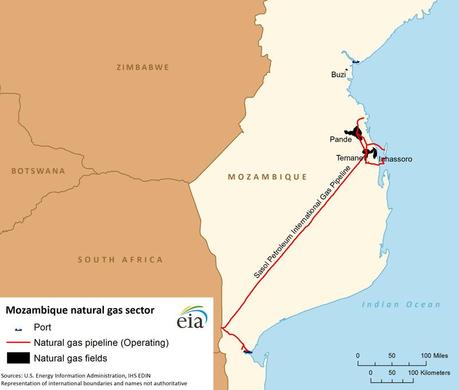
Mozambique natural gas sector (Source: U.S. Energy Information Administration)
Mozambique has large onshore and offshore sedimentary basins that contain hydrocarbon resources. International oil companies (IOCs) began hydrocarbon exploration in Mozambique in 1948. Currently, the country has four proved gas fields, all located onshore in the Mozambique basin: Pande, Buzi, Temane, and Inhassoro, according to the Petroleum Institute of Mozambique. Total proved natural gas reserves in Mozambique were 4.5 trillion cubic feet (Tcf), as of January 1, 2013, according to the Oil & Gas Journal (OGJ). Mozambique does not have proved crude oil reserves.
In 2011, Mozambique produced 135 Bcf of dry natural gas from the Pande and Temane fields, which are both operated by Sasol, a South African energy and chemicals company. Most of the dry natural gas produced in Mozambique was exported (117 Bcf) to South Africa via the 535-mile Sasol Petroleum International Gas Pipeline, and the remainder was domestically consumed (18 Bcf).
The consulting firm ICF International was tasked by the World Bank and the Mozambican government to draft a gas master plan for Mozambique. In the draft, released August 2012, ICF provided its assessment of discovered and undiscovered conventional oil and gas resources in seven regions believed to contain oil and gas deposits. According to the assessment, Mozambique contains almost 46.7 billion barrels of oil equivalent, or 279.9 Tcf equivalent, of discovered and undiscovered oil and gas resources. More than 70 percent of these resources are in the Rovuma offshore north region, which also contains the recent discoveries made by Anadarko and Eni.
Rovuma offshore north 33,237 199.4 20,736 124.4 12,501 75.0
Rovuma offshore south 5,997 36.0 0 0.0 5,997 36.0
Rovuma onshore 524 3.1 0 0.0 524 3.1
Central offshore 2,988 17.9 0 0.0 2,988 17.9
South offshore 2,175 13.1 0 0.0 2,175 13.1
Maniamba basin onshore 203 1.2 0 0.0 203 1.2
South and west onshore 1,530 9.2 576 3.5 954 5.7
Total 46,654 279.9 21,312 127.9 25,342 152.1
Units are in million barrels of oil equivalent (MMboe) and trillion cubic feet equivalent (Tcfe).Discovered plus undiscovered equals total assessed.3P is defined as proven plus probable plus possible resources.Mozambique’s natural gas producing fields, Pande and Temane, are in the south and west onshore region.Anadarko’s Area 1 and Eni’s Area 4 are in the Rovuma offshore north region.Source: ICF International, Natural Gas Plan for Mozambique: Draft Final Executive Summary (August, 2012)
Recent offshore natural gas discoveries

Mozambique offshore Rovuma discoveries. (Source: U.S. Energy Information Administration)
Since 2010, there have been a series of natural gas discoveries in the offshore Rovuma basin that are large enough to support LNG projects. Anadarko and Eni have led exploration activities in their offshore license areas called Area 1 and Area 4. The U.S-based Anadarko operates and owns Area 1, with a 36.5 percent stake, in partnership with Mitsui E&P (20 percent), Mozambique’s Empresa Nacional de Hidrocarbonetos (ENH, 15 percent), BPCL Ventures (10 percent), Videocon (10 percent), and PTT Exploration and Production (8.5 percent). Eni operates Area 4 and owns a 50 percent interest, in partnership with China National Petroleum Corporation (CNPC) (20 percent), GalpEnergia (10 percent), Kogas (10 percent), and ENH (10 percent).
Area 1 contains the Prosperidade Complex, which also straddles across Area 4, and the Golfinho/Atum Complex, which lies entirely in Area 1. The first major discovery in the offshore Rovuma basin was the Windjammer exploration well, made by Anadarko in February 2010, which set the stage for the next dozen discoveries that followed. According to Anadarko, the Prosperidade and Golfinho/Atum Complexes hold about 17-30 Tcf and 15-35 Tcf of recoverable gas resources, respectively. Area 4 holds the Mamba Complex, which also straddles across Area 1, and the Coral finds, which lie wholly in Area 4. The Mamba Complex and the Coral finds contain roughly 62 Tcf and 13 Tcf of gas in place, respectively, according to Eni.
It is unclear what portion of Anadarko and Eni’s resource estimates are economically viable because the two companies report estimates as recoverable resources and gas in place, respectively. Both companies have not yet publically stated reserve estimates for their discoveries and have not indicated the amount that is commercially viable. Thus, resource estimates will likely change as appraisal drilling continues and reserve certification is completed.
Prosperidade Complex operated by Anadarko
Area 1 Windjammer Feb. 2010 17-30 Tcf in total –
Area 1 Barquentine-1 Oct. 2010
Area 1 Lagosta-1 Nov. 2010
Area 1 Tubarao Feb. 2011
Area 1 Barquentine-2 Aug. 2011
Area 1 Camarao Oct. 2011
Area 1 Barquentine-3 Nov. 2011
Area 1 Lagosta-2 Jan. 2012
Area 1 Lagosta-3 Feb. 2012
Area 1 Barquentine-4 Apr. 2012
Golfinho/Atum Complex operated by Anadarko
Area 1 Golfinho-1 May 2012 15-35 Tcf in total –
Area 1 Atum June 2012
Area 1 Golfinho-2 July 2012
Mamba Complex operated by Eni
Area 4 Mamba South-1 Oct. 2011 – 62 Tcf in total
Area 4 Mamba North Feb. 2012
Area 4 Mamba Northeast-1 Mar. 2012
Area 4 Mamba Northeast-2 Aug. 2012
Area 4 Mamba South-2 Dec. 2012
Coral finds operated by Eni
Area 4 Coral-1 May 2012 – 13 Tcf in total
Area 4 Coral-2 Dec. 2012
Area 4 Coral-3 Feb. 2013
The resource estimates will likely change as appraisal drilling continues and reserve certification is completed.Gas in place is the volume of gas in a reservoir and includes both recoverable and non-recoverable gas.The Prosperidade complex extends into license Area 4, while the Mamba Complex extends into license AreaSource: Anadarko, Eni, PFC Energy, and Oil & Gas Journal
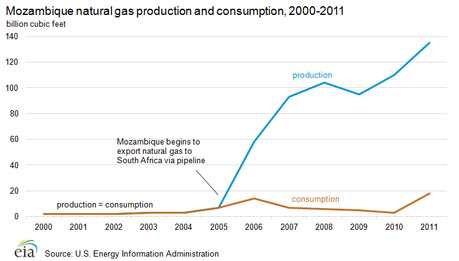
Mozambique natural gas production consumption, 2000-2011 (Source: U.S. Energy Information Administration)
Because the Prosperidade and Mamba Complexes straddle the boundaries of Area 1 and 4, unitization (joint development of reserves that are under separate licenses) between the overlapping areas of the complexes is required under Mozambican law. In December 2012, the Anadarko and Eni signed a Heads of Agreement in which the companies agreed to conduct a separate but coordinated exploration program in the license areas. They also agreed to jointly construct an onshore LNG facility at Afungi Park in the Cabo Delgado province of northern Mozambique, which could cost a total of $50 billion, according to IHS Global Insight.
Anadarko and its partners awarded front-end engineering and design (FEED) contracts for the development of four 5 million tons per annum (MMtpa) LNG trains, including 10 million MMtpa for Area 1 and 10 MMtpa for Area 4, according to Anadarko’s 2012 annual report. Anadarko expects to start selling LNG in 2018, and anticipates that production will reach full operational capacity by 2030-32.
Some industry analysts are skeptical that Mozambique can deliver its first cargo in 2018 and estimate that first LNG will be produced closer to 2020. The onshore LNG site will require a tanker loading facility and substantial onshore infrastructure, according to PFC Energy, which may delay the anticipated start date.
Anadarko and Eni may also build separate LNG facilities that use natural gas produced in the Golfinho/Atum and Coral areas, which do not require unitization. Eni recently submitted development plans to build a floating LNG facility (FLNG) in Area 4, but it did not specify which discoveries would feed the facility, according to IHS Global Insight.
Eni divested 20 percent of its 70-percent stake in Area 4 to the China National Petroleum Corporation (CNPC) in March 2013. CNPC also gained a 28.57-percent stake in Eni’s subsidiary Eni East Africa. Anadarko and its India-based partner Videocon are also seeking to sell a combined 20-percent stake of Area 1. The main companies that are rumored to be in the running are: Shell, Oil and Natural Gas Corporation (ONGC) of India, ExxonMobil, and PetroChina, a unit of CNPC. Shell had placed a bid for an 8.5-percent stake in Area 1 in 2012 but then withdrew and it was awarded to Thailand-based PTTEP. The chairman of Mozambique’s National Petroleum Institute has expressed that Shell would be a strong contender given its LNG experience.
Sector regulation
The National Petroleum Institute (INP) is Mozambique’s regulatory authority for oil and gas exploration and production. The Petroleum Law is the legislation that governs oil and gas activities in Mozambique. The country is in the midst of revising the Petroleum Law, which will encompass fiscal and legislative changes. The country will delay the next licensing round until the changes to the law are adopted. According to IHS Global Insight, there are rumors that the fiscal regime may be relaxed, but local content requirements and state participation are expected to be increased.
Empresa Nacional de Hidrocarbonetos (ENH) is Mozambique’s national oil company and is 100 percent owned by the state. ENH owns a 15-percent stake in Area 1 and 10-percent stake in Area 4.
Tanzania
Oil and gas exploration has been intermittently conducted in Tanzania for the last 60 years. Natural gas discoveries were made at Songo Songo Island and Mnazi Bay in 1974 and 1982, respectively, by Eni’s subsidiary AGIP (Azienda Generale Italiana Petroli). However, it took three decades to achieve the first gas production in Tanzania. Currently, the Songo Songo gas field is the only fully producing gas field in Tanzania, but this may change in the near future if full-scale production at the Mnazi Bay Concession begins as expected. Tanzania had 230 million cubic feet of proved natural gas reserves as of January 1, 2013, according to OGJ. Tanzania does not have proved crude oil reserves.
Natural gas production
The Songo Songo gas field is located on and offshore of Songo Songo Island, located off the coast of Tanzania. Orca Exploration, the field’s current operator, acquired the field in 1991. Commercial production commenced in 2004 and the first gas was delivered to Tanzania’s capitol city, Dar es Salaam, via pipeline that same year. In 2011, the Songo Songo field produced 30.7 Bcf of gross natural gas, all of which was domestically consumed. The gas produced at the Songo Songo field fueled more than 70 percent of Tanzania’s electricity generation, according to Orca Exploration’s 2011 annual report. The company plans to expand gas processing infrastructure and production at the field this year to meet growing domestic power demand.
Orca Exploration believes that natural gas production can be substantially expanded at Songo Songo Island in the future. The company recently discovered sizable gas resources in the northern part of the Songo Songo field, which has not yet been exploited. Orca estimates that combined total recoverable resources at the Songo Songo producing field and the Songo Songo North discovery exceed 1 Tcf of recoverable natural gas resources, as of December 31, 2011. However, the resource estimates have not been proven to be commercially or economically viable. The company is exploring the west section of the field as well.
The Mnazi Bay Concession is located in coastal, south-eastern Tanzania in the Rovuma basin and contains two gas fields, Mnazi Bay and Msimbati. One of the five wells in the concession, MB-1, is already producing gas at a rate of 1.7-2.0 million cubic feet per day (MMcf/d). This gas is transported via a 17-mile pipeline to the Mtwara Power Plant where it generates electricity for local communities, according to one of the concession’s partners Wentworth Resources. The concession is operated by Maurel & Prom (48.06 percent), and production interest is held by Wentworth Resources (31.94 percent) and Tanzania Petroleum Development Corporation (20 percent).
Full-scale gas production at the Mnazi Bay Concession is expected to start once the planned 331-mile Mnazi Bay to Dar es Salaam Gas Pipeline is constructed. Wentworth Resources announced in November 2012 that construction had begun and completion is anticipated in 18 months. China’s Export-Import Bank is funding the project. The concession partners plan to pump 80 MMcf/d of dry natural gas through the pipeline, which would later increase to 200 MMcf/d. However, the pipeline’s construction has received backlash from local communities, and its feasibility was recently questioned by Wentworth Resources.
Recent offshore natural gas discoveries
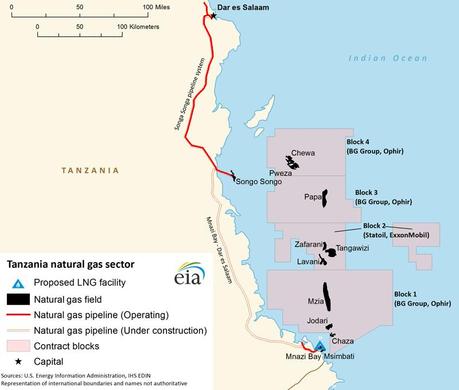
Tanzania natural gas sector (Source: U.S. Energy Information Administration)
Over the last three years, a string of natural gas discoveries have boosted Tanzania’s potential to become a natural gas exporter. Like Mozambique, Tanzania lacks export infrastructure for gas transportation and processing, so much will have to be done if companies follow through with LNG development. It also is unclear how much natural gas will be earmarked for domestic consumption once commercial production begins. Tanzanian offshore discoveries are sizably smaller than Mozambique. Commercial development of the new offshore discoveries will likely start years after its neighboring country.
The BG Group (United Kingdom), in partnership with Ophir Energy (United Kingdom), and Statoil (Norway), in partnership with ExxonMobil (United States), are leading exploration activities in offshore Tanzania. BG and Ophir have made seven discoveries in Blocks 1, 3, and 4, while Statoil and ExxonMobil have made four discoveries in Block 2. United Kingdom-based Aminex, in partnership with Solo Oil, discovered a natural gas and condensate field in 2012 at the onshore Rovuma license. Aminex is currently accepting bids to sell a portion of its license.
Blocks 1, 3, 4 owned by BG Group (60%) and Ophir Energy (40%)
Area 1 Windjammer Feb. 2010 17-30 Tcf in total –
Area 1 Barquentine-1 Oct. 2010
Area 1 Lagosta-1 Nov. 2010
Area 1 Tubarao Feb. 2011
Area 1 Barquentine-2 Aug. 2011
Area 1 Camarao Oct. 2011
Area 1 Barquentine-3 Nov. 2011
Area 1 Lagosta-2 Jan. 2012
Area 1 Lagosta-3 Feb. 2012
Area 1 Barquentine-4 Apr. 2012
Golfinho/Atum Complex operated by Anadarko
Area 1 Golfinho-1 May 2012 15-35 Tcf in total –
Area 1 Atum June 2012
Area 1 Golfinho-2 July 2012
Mamba Complex operated by Eni
Area 4 Mamba South-1 Oct. 2011 – 62 Tcf in total
Area 4 Mamba North Feb. 2012
Area 4 Mamba Northeast-1 Mar. 2012
Area 4 Mamba Northeast-2 Aug. 2012
Area 4 Mamba South-2 Dec. 2012
Coral finds operated by Eni
Area 4 Coral-1 May 2012 – 13 Tcf in total
Area 4 Coral-2 Dec. 2012
Area 4 Coral-3 Feb. 2013
The resource estimates will likely change as appraisal drilling continues and reserve certification is completed.Gas in place is the volume of gas in a reservoir and includes both recoverable and non-recoverable gas.The Prosperidade complex extends into license Area 4, while the Mamba Complex extends into license AreaSource: Anadarko, Eni, PFC Energy, and Oil & Gas Journal
The BG Group and Statoil have had the most success in offshore Tanzania thus far, each finding more than 10 Tcf of recoverable gas resources. News reports indicate that Statoil and BG plan to jointly develop an LNG plant.
Similar to Anadarko and Eni in Mozambique, the BG Group and Statoil have not publically released a reserve estimate for their discoveries, so it is unclear what portion of the discovered resources are economically viable to extract from the ground. Resource estimates will likely change as appraisal drilling continues and reserve certification is completed.
Sector regulation
The Tanzania Petroleum Development Corporation (TPDC) is a state corporation, under the Ministry of Energy and Minerals, that implements petroleum exploration and development policies. TPDC’s objectives are to explore and produce petroleum and participate in oil and gas production with IOCs. It acts as the country’s national oil and gas company and currently has an equity stake in the Mnazi Bay gas development projects.
Tanzania is working to finalize gas policies and regulations, which will be encompassed in a new Gas Master Plan and the downstream-focused Natural Gas Act. The government issued a draft natural gas policy for stakeholders to review on November 1, 2012, according to Orca Exploration. The draft suggests a possible restructuring of TPDC and an expansion of its role across the upstream, midstream, and downstream sectors. The draft also promotes the expansion of the midstream and downstream sectors by developing facilities for natural gas processing, liquefaction, transportation, storage, and distribution. The draft gas master plan may also emphasize a preference for the domestic market over exports, according to an article by the Financial Times.
TPDC expects the Gas Master Plan and the Natural Gas Act to be finalized this year, which may be followed by a licensing round. Bidding terms and block details for the licensing round will most likely be released after the new Exploration and Production Bill, replacing the current laws and regulations, is passed.
Meanwhile, TPDC is continuing its review of terms held in oil and gas exploration contracts. The review began in the second half of 2012 and was part of the government’s broader goal of replacing antiquated regulations. According to IHS Global Insight, the new contract terms will include higher oil and gas production royalties and a larger state participation requirement, which is a trend in other East African countries seeking to benefit from new commercial discoveries and growing reserve estimates. The changes to contract terms, coupled with the revisions to regulations and laws, adds to the uncertainty that companies currently doing business or planning to enter Tanzania are facing.
Mozambique and Tanzania: Additional considerations
One of the biggest uncertainties that Mozambique and Tanzania face is the global LNG market up to and beyond 2020. Previous estimates from the energy consulting firm Wood Mackenzie showed an oversupply of LNG by 2020, as global LNG supply surpassed demand by about 100 MMtpa. Similarly, IHS Cera’s long-term global LNG outlook forecasts that global liquefaction capacity will continue to exceed demand, with the gap widening in 2017 and onwards. On the other hand, Chevron projects that global LNG demand will outstrip supply by about 120 MMtpa by 2025, resulting in a supply shortfall.
The growth of global liquefaction capacity and demand will depend on many factors, some of which are still uncertain and will most likely become clearer toward the end of this decade. Some of these factors include: shale gas supply growth in North America and China, growth in liquefaction capacity in various regions (particularly in North America, Australia, the Middle East, and East Africa), regional LNG demand growth (particularly in Asia), the expansion of LNG in transportation sectors in various countries, fuel price differentials, the expansion of technologies and infrastructure, and several others.
Given these uncertainties, some analysts believe that project start-dates will be crucial for new LNG producers such as Mozambique and Tanzania because various LNG projects in different parts of the world are expected to come online over the next decade. Market analysts have also warned that Mozambique and Tanzania should focus on securing long-term LNG contracts and/or sell stakes in their LNG projects to Asian investors that are big LNG buyers, which could support Eni’s reason for divesting a stake in its Mozambique license to CNPC.
Some Asian companies have been in talks with Anadarko and its partners over future LNG sales such as Japan’s Osaka Gas and the Tokyo Electric Power Company (TEPCO), Japan’s largest gas consumer. But securing contracts now will depend on the production start-up dates and pricing. TEPCO, in cooperation with Tokyo Gas, is seeking a price that is indexed to the U.S. Henry Hub price, because long-term LNG off-take agreements are traditionally linked to crude oil prices, making the price for LNG more expensive.
Mozambican LNG is lean (predominantly methane with small quantities of ethane with a low heating value). According to IHS Global Insight, Asian buyers have traditionally favored rich LNG with a high heating value from Australia, but TEPCO’s long-term contracts for rich-LNG will expire in 2018-2019. TEPCO is looking to replace some contracts with future purchases of lean LNG and is planning to build new storage facilities for lean LNG at some LNG terminals at Tokyo Bay, according to news reports.
Alternative markets
Amid uncertainties surrounding global LNG demand, Mozambique and Tanzania are looking at different ways to monetize their natural gas alongside LNG development. Eni has said it is considering domestic and regional markets to sell a portion of its gas supply, either in the form of compressed natural gas (CNG) for transportation or natural gas for power generation. In Tanzania, there is already a modest CNG market in Dar es Salaam. CNG fuels industries and hotels and is available for trucks and buses. Tanzania also has expressed plans to expand gas-fired plants to decrease its reliance on hydropower, which has been affected by droughts in the past. In Mozambique’s draft gas master plan, ICF International identified potential domestic industries that could use natural gas, outside of LNG and power generation, which would offer Mozambique opportunities to start domestic value-added industries. One possibility is methanol plants, as methanol is a feedstock to several industrial chemicals and is a major market in China. Another industry is fertilizer production, which ICF international suggests could be sold locally and regionally. European demand for gas-to-liquids (GTL) is also strong, where it can substitute for higher-cost diesel, gasoline, and jet fuel, according to ICF. Mozambique has already hinted at building a GTL facility that may be backed by Sasol, one of the world’s largest GTL operators. Nonetheless, similar to LNG, risks still exist in all of these industries, mainly related to global over-supply, energy prices, and large capital investments.
South Africa is also looking to decrease its reliance on coal, and it hopes to increase its purchases of natural gas from Mozambique once offshore production commences.
Oil developments: Uganda, Kenya, and Madagascar
Uganda
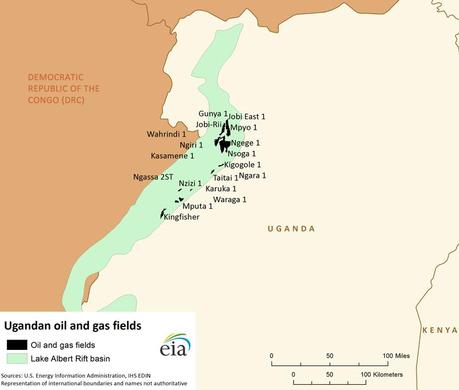
Uganda oil and gas fields (Source: U.S. Energy Information Administration)
Oil exploration in Uganda dates back to the early 1920s after oil seeps were reported along the shores of Lake Albert, according to the country’s Ministry of Energy and Mineral Development. Exploration activities slowed for most of the century, mainly because of political instability but restarted in the 1980s. In 2006, the first commercial oil discovery was made in the Lake Albert Rift basin at the Mputa-1 well, and discoveries soon followed at the Waraga-1 and Nzizi wells. Since then, over 50 wells were drilled at the Lake Albert Rift basin, and the vast majority encountered oil. Successful well appraisals have boosted Uganda’s proved crude oil reserves from zero in 2010 to 2.5 billion barrels as of January 1, 2013, according to OGJ. In addition, the country contains 500 Bcf of proved natural gas reserves, which are also located in the Lake Albert area.
The oil companies currently leading exploration and development in Uganda are the UK-based Tullow, Paris-based Total, and the China National Offshore Oil Corporation (CNOOC). In 2011, Tullow sold part of its stakes in its four blocks (1, 1A, 2, and 3A), which are all located in the Lake Albert Rift basin. Tullow, Total, and CNOOC now each own a third of each block. Total is the operator of Block 1 and 1A, Tullow of Block 2, and CNOOC of Block 3A. The companies are currently embarking on extensive drilling and appraisal programs to confirm commercial viability at well discoveries, which could ultimately boost the country’s proven oil reserves (Tullow’s Exploration and Appraisal Program 2013).
Mputa 1 Oil 2006 Awaiting development approval Tullow Block 2
Nzizi 1 Oil/Gas 2006 Awaiting development approval Tullow Block 2
Waraga 1 Oil 2006 Awaiting development approval Tullow Block 2
Jobi-Rii Oil/Gas 2008 Appraising Total Block 1/1A
Kingfisher Oil 2006 Awaiting development approval CNOOC Block 3
Gunya 1 Oil 2011 Appraising Total Block 1/1A
Jobi East 1 Oil/Gas 2011 Appraising Total Block 1/1A
Ngiri 1 Oil/Gas 2008 Appraising Total Block 1/1A
Kasamene 1 Oil/Gas 2008 Appraising Tullow Block 2
Kigogole 1 Oil 2008 Appraising Tullow Block 2
Ngassa 2ST Oil 2009 Appraising Tullow Block 2
Nsoga 1 Oil 2009 Appraising Tullow Block 2
Ngege 1 Oil/Gas 2008 Appraising Tullow Block 2
Taitai 1 Oil/Gas 2008 Discovery Tullow Block 2
Wahrindi 1 Oil 2009 Appraising Tullow Block 2
Mpyo 1 Oil 2010 Appraising Total Block 1/1A
Karuka 1 Oil 2008 Discovery Tullow Block 2
Ngara 1 Oil 2009 Discovery Tullow Block 2
Source: Tullow, Total, Rystad Energy, and IHS Edin
Oil production outlook
The start of oil production in Uganda will largely depend on when infrastructure to process and transport the crude oil is completed. Initial output will most likely be used to power local electricity plants, according to Tullow. Small-scale oil production is expected to first come from the Mputa and Waraga fields and small-scale gas production from the Nzizi field. Full-scale oil production is expected to start in 2017, a year later than previously anticipated, according to Total.
The Ugandan government and Total and CNOOC recently reached an agreement to build a 30,000-bbl/d oil refinery, instead of the 180,000-bbl/d refinery that the government wanted. The agreement marks the end of a lengthy dispute that delayed the start of oil production. Nonetheless, the government and the consortium (Total, Tullow, and CNOOC) still have to decide on daily production levels and the export pipeline route. The government prefers a gradual ramp-up and lower peak output to slow the depletion of reserves, while the consortium favors production ramping up quickly and peaking at 200,000 bbl/d or more by 2020, according to reports from the Eurasia Group and IHS Global Insight. The consortium has studied three export pipeline routes: via Kenya’s Mombasa terminal, via Kenya’s Lamu terminal, and via Tanzania’s Dar es Salaam port. The routes through Kenya are seen as more viable than the route through Tanzania. But the viability of the route through Lamu will depend on whether the Kenyan government follows through on its plans to develop the port and terminal at Lamu.
Sector regulation and development
Uganda’s National Oil and Gas Policy was enacted in 2008, and the Parliament recently passed two bills to operationalize the policy: the Petroleum (Exploration, Development and Production) Bill and the Petroleum, Refining, Conversion, Transmission, and Midstream Storage Bill. The purpose of the bills is to establish the framework and institutions to regulate upstream, midstream, and downstream petroleum activities. The Petroleum Bill established a Petroleum Authority and a National Oil Company (NOC) and outlined the functions of the Ministry of Energy. The Petroleum Bill had sparked debate in Uganda’s Parliament over whether the bill granted too much authority to the Ministry of Energy, particularly regarding the discretion to grant and revoke licenses. Despite the debate, the Ministry of Energy was granted those discretionary powers, among several others.
According to the Petroleum Bill, the Ministry of Energy is responsible for granting and revoking licenses (and may also open new areas for licensing), developing and implementing oil and gas policy, issuing regulation, approving field development plans, and negotiating petroleum agreements. The Petroleum Authority is in charge of monitoring and regulating petroleum activities, and it oversees the review and approval process for exploration plans and budgets submitted by a licensee. The Petroleum Authority is also expected to advise the Ministry during negotiations of petroleum agreements and provide them with recommendations during the approval process for field development plans submitted by investors. Regarding the midstream and downstream sectors, the Petroleum Authority is responsible for monitoring and regulating petroleum refining, gas processing and conversion, transportation, and storage. The Petroleum Bill also established the National Environment Management Authority (NEMA) to oversee environmental regulations in oil and gas activities.
Under the Petroleum Bill, the NOC is authorized to manage the state’s commercial interests and participation in petroleum activities and administer joint venture contracts. The bill also authorizes the NOC to pursue upstream, midstream, and downstream ventures locally, and later internationally. The bill imposes some local content requirements. Companies are expected to give preferences to Ugandan goods and services, unless imported goods or services provide the company with better quality and timeliness in availability. Entities must submit plans for the recruitment and training of Ugandans in all phases of petroleum activities.
Kenya
Kenya has a history of oil exploration dating back to the 1950s. However, most of the wells that were drilled in the past came up dry. After decades of disappointing results, investments in Kenyan hydrocarbon exploration waned until 2010 when offshore gas finds in Mozambique and Tanzania and onshore oil finds in Uganda attracted investors back to Kenya. Exploration is currently being conducted in Kenya’s four sedimentary basins: Lamu (both onshore and offshore), Lokichar (Mandera), Anza, and Tertiary Rift.
In 2012, Tullow, in partnership with Africa Oil and Marathon, discovered oil at Ngamia-1 in Block 10BB and Twiga South-1 in Block 13T in the onshore Lokichar basin. According to Tullow, the Ngamia-1 find exceeded expectations and decreased the risk of pursuing other prospects in the southern part of the Lokichar basin. Tullow will test flow rates at the two wells and continue exploration activities in the area to determine whether the finds will be commercially viable. Apache also discovered gas at the offshore Mbawa-1 well; however, Apache has since plugged the well after failing to find commercial quantities of natural gas or crude oil.
Oil production outlook
With just two recent notable oil finds, it is still highly uncertain when Kenya will begin commercial production. Local officials have projected that oil production could start in another six years, but this is very optimistic because the country is still unsure of the size of proved reserves and the commercial viability of finds. As of January 1, 2013, Kenya does not have any proved crude oil or natural gas reserves, according to OGJ.
Sector regulation
Kenya’s Ministry of Energy is in charge of oil and gas exploration and upstream regulation. The ministry oversees the service delivery of state companies, such as the National Oil Corporation of Kenya (NOCK), Kenya Pipeline Company (KPC) Limited, and Kenya Petroleum Refineries Limited (KPRL). The Minister is also the licensing authority and has the power to make licensing regulations, although in practice NOCK acts as the licensing authority and negotiates with foreign companies, according to IHS Global Insight.
Foreign companies exploring in Kenya operate under a production-sharing contract (PSC), in which the government can participate through NOCK. Companies are contractually obligated to give 25 percent of their block back to the government after two years if it is located onshore, and after three years if it is offshore. The rule is meant to encourage exploration in block areas that are not being explored. PSCs also contain an obligation for domestic supply of oil and gas.
Midstream and downstream oil infrastructure
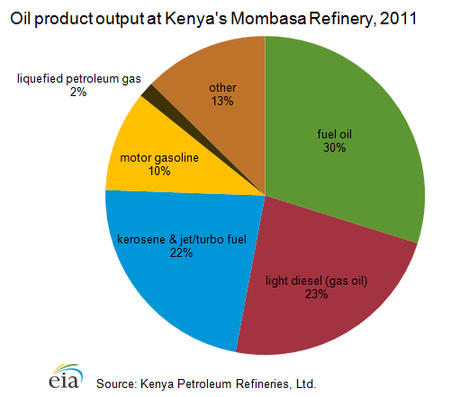
Oil product output at Kenya’s Mombasa Refinery, 2011 (Source: Kenya Petroleum Refineries, Ltd.)
The Mombasa Port, which is managed and operated by the Kenya Ports Authority, serves international trade to and from Kenya, Uganda, Rwanda, Burundi, the Democratic Republic of Congo (DRC), and South Sudan. The port comprises the Kilindini Harbour, Port Reitz, and the Old Port and is the country’s largest seaport.
Crude oil is one of Mombasa Port’s main imports, and the port has two oil terminals and one refinery to receive and process the crude. The Kipevu Oil Terminal is located in the Port Reitz area and can accommodate crude oil tankers up to 100,000 deadweight tons (dwt) while the Shimanzi Oil Terminal can hold vessels up to 30,000 dwt. The Mombasa refinery is one of the largest petroleum refineries in East Africa and has a nameplate capacity of 90,000 bbl/d, with a throughput of almost 35,000 bbl/d in 2011. The refinery processes heavy crude from Abu Dhabi and other heavy Middle-Eastern crude grades. In 2011, Kenya imported around 35,000 bbl/d of crude oil entirely from the United Arab Emirates, according to the Kenya National Bureau of Statistics (KNBS), as reported by Global Trade Atlas (GTA). About 75 percent is processed into fuel oil, light diesel (gas oil), kerosene, and jet/turbo fuel.
Kenya also imports refined oil products, mainly from the Middle East and Asia. The country imported around 56,000 bbl/d of refined oil products in 2011, according to KNBS, as reported by GTA. Most of the products are sold in Kenya’s major cities, and the remainder is exported to nearby countries. Kenya has a product pipeline system that transports petroleum products inland. Kenya’s first product pipeline, the Mombasa to Nairobi pipeline, came online in 1978 and began supplying petroleum products to western Kenya. To enhance the supply to other parts of Kenya and nearby countries, KPC constructed the Western Kenya Pipeline Extension (WKPE), which runs from Nairobi to Nakuru, Eldoret, and Kisumu.
In 2012, KPC announced that it planned to replace the aging 280-mile Mombasa to Nairobi pipeline, which is estimated to cost $300 million. The pipeline is in poor condition and requires maintenance work. The growth of petroleum product demand in Kenya and nearby countries has placed pressure on the pipeline system, and the throughput has greatly surpassed its initial flow. In 2009, total throughput for the Mombasa to Nairobi and WKPE system increased to its highest level of 75,000 bbl/d, according to data from KPC. More than half of the petroleum products are destined for Nairobi and consumed by the city’s major centers, such as the Jomo Kenyatta International Airport.
Proposed oil infrastructure projects
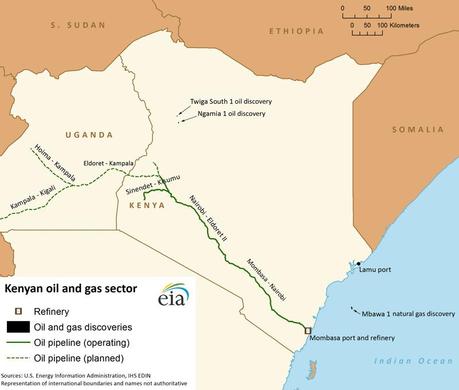
Kenya oil gas sector (Source: U.S. Energy Information Administration)
In addition to replacing the Mombasa to Nairobi pipeline, Kenya is also embarking on a host of new infrastructure projects that extend out to nearby countries. Kenya hopes that these planned projects will strengthen its role as a regional oil transit hub.
KPA is embarking on a multi-million dollar investment to improve the productivity and throughput capacity at the Mombasa Port. The country anticipates that increased demand for goods in Kenya and nearby countries, coupled with new oil transit pipelines from Uganda and possibly South Sudan, will increase port activity in the coming years. Currently, the port handles about 19.6 tons of cargo, of which 14 million tons was imported by Kenya and about 5 million tons was in transit from nearby countries, according to KPA. Uganda accounts for most of the regional transit, making up 80 percent of the 5 million tons.
Kenya is also working with Uganda to extend the Nairobi-to-Eldoret pipeline to Kampala, the capital of Uganda. The current 218-mile Nairobi to Eldoret product pipeline terminates at Eldoret in western Kenya. The plan is to connect the pipeline to a new reversible 220-mile pipeline that travels to Kampala, which will have the ability to change the direction of its flow to transport products to Eldoret from Kampala as well. The contract to construct the pipeline was originally awarded to Libya’s Tamoil, but the company was not able to fulfill its contract, and it was cancelled by the Kenyan and Ugandan government. Both governments are currently reviewing new bids from interested investors. The pipeline may be extended to Rwanda in the future.
The country also launched the Lamu Port and South Sudan and Ethiopia Transport (LAPSSET) project in 2012 and has begun preliminary construction of some of its components. The LAPSSET project includes the construction of: a new deepwater port in Lamu, a 120,000-bbl/d oil refinery at the port, pipelines from Lamu to Ethiopia and South Sudan to Lamu, a LAPSSET highway, and a railway line. According to the project’s progress report, most of the components have not been implemented yet, and some are behind schedule. For example, the target date to complete the oil refinery is 2015; however, construction has not yet started.
Other proposed pipeline projects are the Nairobi-to-Arusha (Tanzania) pipeline and the Lake Albert (Uganda)-to-Kenyan Coast pipeline. The Nairobi-to-Arusha proposed pipeline would supply oil from Kenya’s Turkana County, once commercial production began, to Tanzania. The Lake Albert-to-Kenyan Coast proposed export pipeline would monetize oil production from the Lake Albert Rift basin.
Madagascar

Madagascar oil discovery (Source: U.S. Energy Information Administration)
Oil and gas exploration in Madagascar has been going on for over 100 years, mainly in the Morondava basin. The country’s most promising asset, the Tsimiroro oil field, was discovered almost a century ago, but prior to 2008 it was believed to contain only 300 million barrels of heavy crude oil, so it was deemed not commercially viable. However, an extensive drilling campaign, coupled with a method to heat the heavy crude known as cyclic steam stimulation (CSS), has boosted Tsimiroro’s current estimate to 1.7 billion barrels of recoverable oil resources, according to the field’s operator Madagascar Oil.
Madagascar also holds large oil sands deposits (petroleum deposits of bitumen also known as tar sands). The Bemolanga Project, also situated in the Morondava basin, contains 2 billion barrels of bitumen deposits in place. In 2009, Total and Madagascar Oil were exploring plans to embark on a capital-intensive mining project to extract the oil, but the companies decided that it would not be economically viable because a low recovery rate of 12 percent was expected.
The Manambolo, Morondava, and Manandaza licenses, which are located onshore to the south of Tsimiroro and Bemolanga, are also believed to hold oil and gas resources ranging from 240 to 500 million barrels, according to Madagascar Oil, the owner of the three licenses. Out of the three licenses, the Manandaza is believed to be the most promising because light oil was once discovered; however, the well was considered non-commercial after only 10 barrels of oil flowed from a very poor reservoir. Madagascar Oil continues to conduct geologic studies on the area to assess its potential.
The offshore Morondava basin is also believed to contain large untapped deposits of hydrocarbons, according to an assessment by the United States Geological Survey (USGS). USGS estimates that the mean technically recoverable resources that are undiscovered in the offshore Morondava basin are: 10.8 billion barrels of oil, 167 Tcf of natural gas, and 5 billion barrels of natural gas liquids.
Oil production outlook
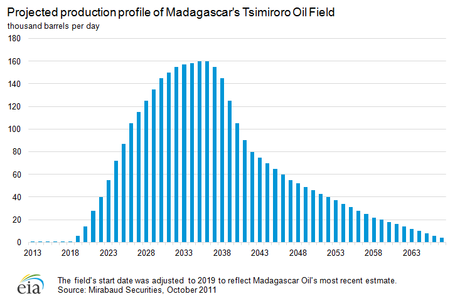
Projected production profile of Madagascar Tsimiroro Oil Field (Source: Mirabaud Securities, October 2011)
Madagascar Oil expects to start small-scale production at the Tsimiroro field sometime in 2013 as part of a steam flood pilot project. Heavy crude oil production from the pilot project is anticipated to peak at the end of 2013 or early 2014 at 1,200 bbl/d. The purpose of the 25-well pilot project is to test the commerciality of the field under a steam-flood recovery method in which steam will be used to heat the oil underground and change its viscosity before it is extracted. The steam-flood method is expected to deliver a recovery factor of about 70 percent, which is much higher than the CSS recovery factor of around 16 percent, according to Madagascar Oil.
Assuming that the pilot program is successful, Madagascar Oil anticipates commercial oil production at Tsimiroro will commence in 2019 and eventually ramp up to its peak production of 150,000-160,000 bbl/d. The company estimates that the cost of fully developing the field will be $1.5 billion, most of which will go towards building an export terminal on site, a pipeline to transport the oil to the coast, a marine terminal, and an offshore mooring facility. Tsimiroro’s production profile and development costs will most likely be revised once the steam-flood pilot project is completed and Madagascar Oil has a clearer picture of the field’s potential.
Sector regulation
The Office of National Mines and Strategic Industries (OMNIS) is in charge of the upstream hydrocarbon sector. OMNIS is a state-owned entity under the authority of the Prime Minister and supervision of the Ministry of Energy and Mines. The Petroleum Code outlines the regulations for exploration, production, and transportation of liquid, as well as solid and gaseous hydrocarbons in Madagascar. OMNIS grants exploration, production, and transportation permits to foreign oil companies, which are subject to a royalty tax that could range from 8 to 20 percent, a direct hydrocarbon income tax, and other taxes.
In 2011, Madagascar Oil concluded a dispute with the Malagasy government over the validity of the Tsimiroro field and the Manambolo, Morondava, and Manandaza exploration licenses. The dispute began in December 2010 when the government indicated interest in acquiring Madagascar Oil’s assets, excluding the Bemolanga field, which the company considered to be the government’s attempt to expropriate its oil assets. A few months later, Madagascar Oil declared force majeure under the four PSCs in order to safeguard its rights under those agreements during arbitration with the government. In June 2011, the dispute over the Tsimiroro field was resolved once the government approved a work program for the field, hence acknowledging the validity of the company’s PSC. Almost a year later, all outstanding issues were resolved, and the company resumed work at the exploration blocks in April 2012.

